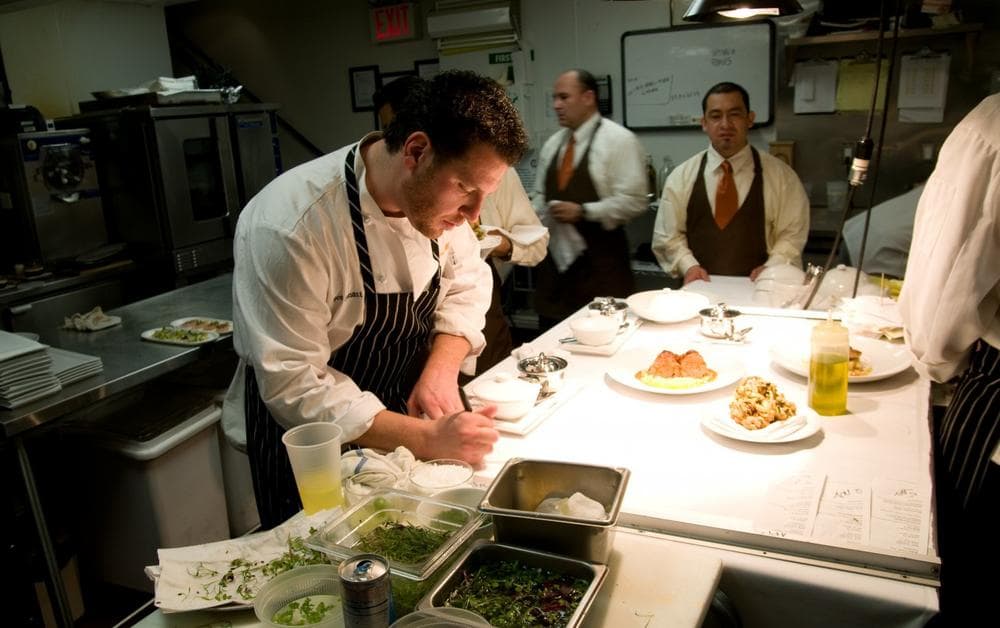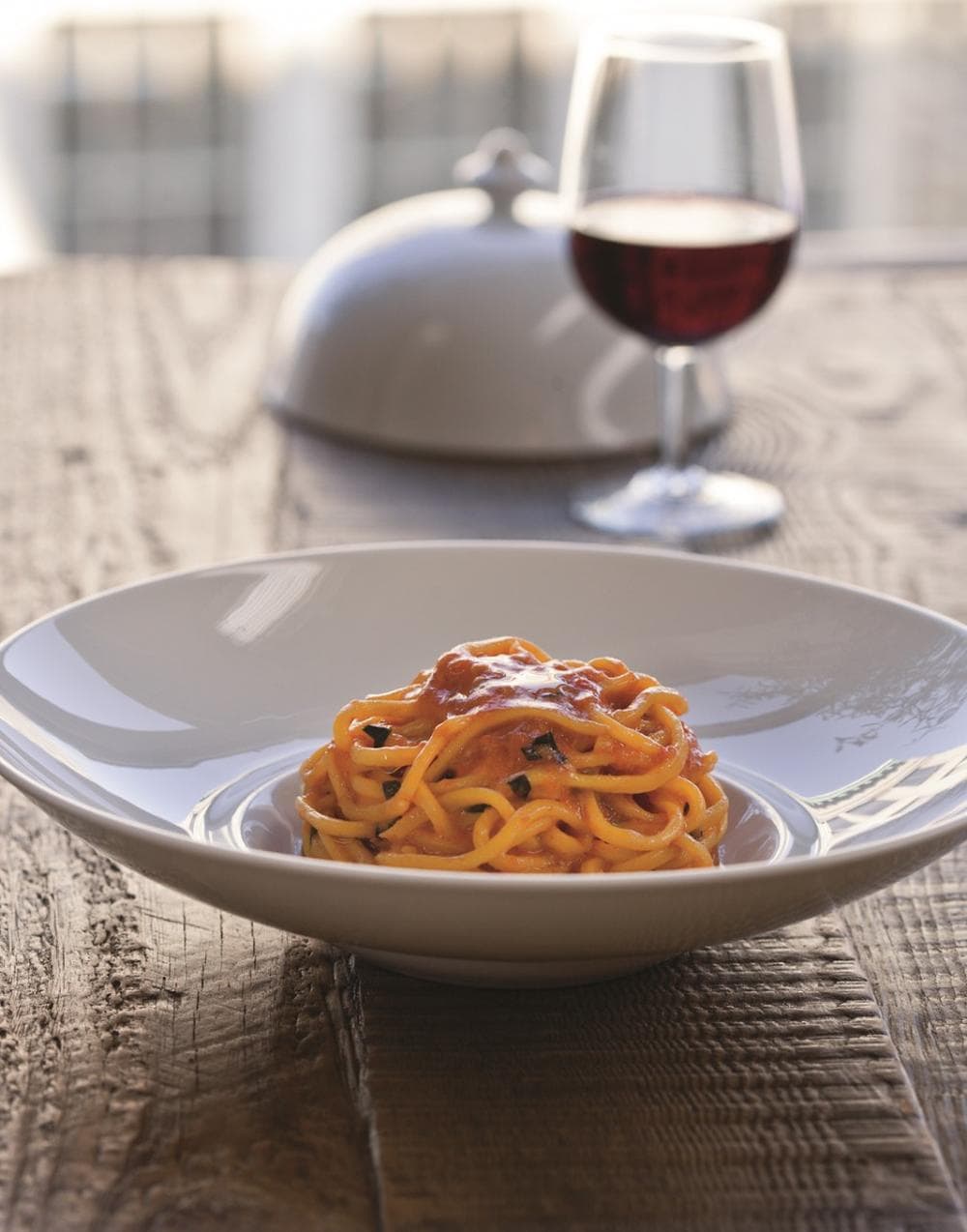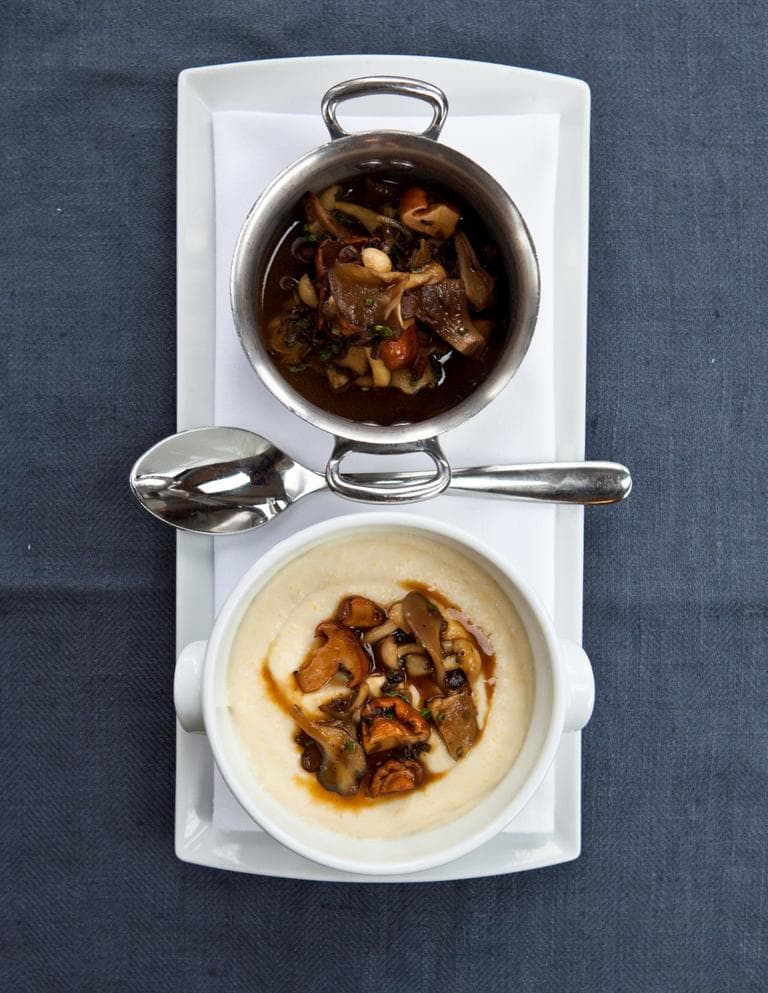Advertisement
Chef Scott Conant Brings Restaurant Fare To New Cookbook
Resume
Food Network fans might know chef Scott Conant best as a tough judge on the cooking competition show "Chopped." But he's also the creator of "Scarpetta," the Italian restaurant that now has locations in New York, Miami, Beverly Hills, Las Vegas and Toronto.
For those who want to try cooking his restaurant fare at home, Conant has published "The Scarpetta Cookbook: 125 Recipes From the Acclaimed Restaurant." The book includes his take on spaghetti with tomato sauce, as well as a recipe for Mushroom Fricassee with Creamy Polenta that, as Conant tells Here & Now's Jeremy Hobson, "my wife always gets annoyed with me when I say this, but when I was single, that dish — you know, I would be able to get dates with that dish."
Conant shares two multi-part recipes:
Reprinted from the book “The Scarpetta Cookbook” by Scott Conant, Copyright 2013, with permission from the publisher, Houghton Mifflin Harcourt. All rights reserved.
Scarpetta Spaghetti with Tomato Sauce
(printer-friendly PDF of all recipes)
Scott’s Note: This spaghetti is among the first recipes of mine that got a lot of attention, and I love that fact because it exemplifies everything I believe in as a chef: treating ingredients with respect, paying attention to detail, and elevating simplicity.
Which wine? A red wine with low acidity will counter the intense tomato sauce. Barbera or Dolcetto should work well. Choose a classic with medium body and dark red fruits, like Enaudi or Marcarini.

Serves 4
Ingredients:
Kosher salt
Scarpetta Tomato Sauce (recipe follows)
1 pound Fresh Spaghetti (recipe follows)
½ cup freshly grated
Parmigiano-Reggiano cheese
2 tablespoons (1 ounce) unsalted butter, cut into pieces
16 whole fresh basil leaves, cut into chiffonade
Extra-virgin olive oil, for drizzling
Instructions:
Bring a large pot of well-salted water to a boil.
Meanwhile, put the tomato sauce in a large sauté pan and cook over medium heat to further concentrate the sauce’s flavors.
Cook the spaghetti until just shy of tender. Reserve some of the pasta cooking water and gently drain the spaghetti. Add the spaghetti and a little of the pasta cooking water to the pan with the sauce; the starch and salt in that water will help the sauce adhere to the pasta. Give the pan a good shake, increase the heat to medium-high, and let the pasta finish cooking in the sauce. The sauce should coat the pasta and look cohesive, and when you shake the pan, the sauce and pasta should move together.
Take the pan off the heat and add the Parmigiano-Reggiano, butter, and basil. Using two wooden spoons (tongs can tear the fresh pasta), toss everything together well.
Divide the pasta among serving bowls. Finish with a drizzle of extra-virgin olive oil and serve.
Scarpetta Tomato Sauce
Scott’s Note: I know it seems crazy that this sauce, which paired with fresh spaghetti is a signature dish at Scarpetta, is in the pantry chapter of the book. But this is also what we use in every recipe that calls for tomato sauce, whether it’s by the tablespoon or the cup. The infused oil is the secret that makes this sauce so great. Not only does it give the sauce a supple texture, but it also reinforces the flavors of the basil and the crushed red pepper while introducing just a hint of garlic. And it’s about as easy to make as a cup of tea; you simply let the ingredients steep in the hot oil. For the best consistency, use a potato masher to break up the tomatoes as they cook. It’s a trick I learned from watching tomato sauce preparation in my Italian household.
Makes 3 cups
Ingredients:
Extra-virgin olive oil
12 plum tomatoes, peeled and seeded, plus any juices from peeling and seeding, strained and reserved *
Kosher salt
10 cloves garlic
3 sprigs fresh basil (about 24 leaves plus stems)
1 to 1 ½ teaspoons crushed red pepper flakes
* If your tomatoes are not ripe, bright, and juicy, reduce the number of fresh tomatoes to 8 and add 4 whole canned San Marzano
Instructions:
In a wide saucepan, heat 3 tablespoons olive oil over medium-high heat. Add the tomatoes; be careful, as the oil may spurt. Add 1 ½ teaspoons salt and cook, stirring occasionally, until the tomatoes soften, 2 to 3 minutes. Lower the heat to medium and, using a potato masher, smash the tomatoes, really working the masher to break them up. If the consistency is thick, add the reserved tomato juice to the pan. Cook, occasionally mashing and stirring, for 20 minutes.
Meanwhile, in a small saucepan, heat ½ cup extra-virgin olive oil over medium heat. Add the garlic, basil, and red pepper flakes and cook, stirring occasionally to wilt the basil, until the garlic is golden brown, about 5 minutes. Remove the oil from the heat and let the ingredients steep for 5 minutes.
Strain about half of the oil into the cooked tomatoes. (Strain and reserve the rest of the flavorful oil; it’s a great bread-dipping oil.) Stir to combine. Remove the sauce from the heat. Taste and add additional salt, if needed. The sauce may taste spicy on its own, but it gets balanced when used with other ingredients, especially the pasta, butter, and cheese in the Scarpetta Spaghetti.
The sauce will keep, covered and refrigerated, for 2 days. Reheat gently before serving.
Fresh Pasta
Makes about 3 pounds
Ingredients:
3 cups “00” flour, plus more as needed
1½ teaspoons kosher salt
11 large egg yolks
3 large eggs
2 tablespoons extra-virgin olive oil
Instructions:
In a stand mixer fitted with the dough hook, combine the flour and salt on low speed. Add the egg yolks, eggs, and olive oil and continue to mix on low speed. Once the flour is incorporated, increase the speed to medium-low and mix/knead the dough for 5 minutes.
Lightly flour your work surface. Dump the dough onto the surface and continue to knead for a few more minutes. At this point, the dough may look a little dry, which is fine. Wrap the dough well in plastic wrap and let it rest in the refrigerator for at least 1 hour before rolling it. This rest allows the flour to be fully absorbed by the wet ingredients for a smooth, tender dough. (You can make the dough up to 1 day ahead of rolling it; keep it refrigerated.)
To roll and shape the dough, set the pasta machine on its widest setting. Cut the pasta dough into 4 pieces. Work with one piece at a time and wrap the others in plastic wrap to prevent them from drying out. Very lightly flour the dough and run it through the pasta machine twice. Fold it in half and run it through again. Do that a couple more times; this serves as a final kneading. Set the machine to the next level of thickness and run the piece of dough through again. Keep running the dough through the machine, adjusting the rollers to a thinner setting each time, until the sheet is the thickness you want or the recipe directs.
Lightly flour the dough throughout the process if it is sticking; the additional flour added at this point will not make it tough. (If the finished sheets of pasta have a lot of flour on them, brush it off using a brush with dark bristles so you can see any stray bristles should they come off on the pasta.)
For fettuccine and linguine: Lightly flour a rimmed baking sheet. Roll the dough into sheets about ¹⁄16 inch thick. Cut the sheets of pasta with the pasta roller designated for that shape. Gather the strands into nests by wrapping portions around your hand. Dust the nests with a little more flour, place on the baking sheet, and freeze until hard. (Once the pasta is rock-hard, it can be transferred to a freezer bag or other airtight container and kept frozen for up to 1 month.)
For pappardelle: Lightly flour a rimmed baking sheet. Roll the dough into sheets about ¹⁄16 inch thick. Use a plain or fluted ravioli cutter or a sharp chef’s knife to cut long, ½-inch-wide strips of pasta. Gather the strands into nests by wrapping portions around your hand. Dust the nests with a little more flour, place on the baking sheet, and freeze until hard. (Once the pappardelle is rock-hard, it can be transferred to a freezer bag or other airtight container and kept frozen for up to 1 month.)
Mushroom Fricassee with Creamy Polenta
Scott’s Note: This is a quintessential Scarpetta dish that has not lost its popularity over the years. At the restaurant, waiters bring these mushrooms to the table in tiny saucepans. The lid to the pan is ceremoniously lifted, and you first experience the dish with what I call “the breathe,” that initial aromatic hit that puts the dish right in your head. The mushrooms and their cooking juices are then spooned over a waiting bowl of our creamy polenta.
Which wine? This rich dish needs a wine with intensity and weight to match the richness of the polenta and the woody nature of the mushrooms. A red from Umbria, like Caprai Montefalco Riserva or Sagrantino from Fattoria Scacciadiavoli, would fit the bill.

Serves 4
Ingredients:
6 tablespoons plus 1 teaspoon extra-virgin olive oil
4 medium shallots, halved and thinly sliced lengthwise
Kosher salt
10 ounces mixed domestic and wild mushrooms, sliced or cut into bite-size pieces (about 4 cups)
2 sprigs fresh thyme
2 cups Chicken Reduction (recipe follows), plus more as needed
1 tablespoon preserved black truffles
1 tablespoon chopped fresh chives
Pinch of crushed red pepper
3 cups Creamy Polenta (recipe follows)
Instructions:
In a medium saucepan, heat the 6 tablespoons olive oil over medium heat. Add the shallots, season lightly with salt, and cook, stirring, until the shallots just begin to color, about 4 minutes. Add the mushrooms, thyme, and the remaining 1 teaspoon olive oil, and cook, stirring occasionally, until the mushrooms release their liquid, about 2 minutes. Add the Chicken Reduction, bring to a boil, then reduce to a simmer. Cook, stirring occasionally, until the liquid is reduced by half and has a saucy consistency, 2 to 3 minutes. Stir in the preserved truffles. If the mixture thickens too much—you want the mushrooms to be swimming in the sauce but there should be a mushroom in every bite—add 2 tablespoons of the Chicken Reduction to thin it out a bit. Stir in the chives and crushed red pepper.
Divide the Creamy Polenta among serving bowls. Top with the mushrooms and their cooking liquid and serve immediately.
Creamy Polenta
Serves 8 to 10
Ingredients:
4 cups heavy cream
4 cups whole milk
1 tablespoon kosher salt
1 cup coarse polenta
4 tablespoons (2 ounces) unsalted butter
⅓ cup freshly grated
Parmigiano-Reggiano cheese
Instructions:
In a large, heavy-based saucepan over medium-high heat, heat the cream and milk until warm, about 5 minutes. Whisk in the salt and keep whisking until the liquid is very frothy (like a cappuccino) and hot. While still whisking, slowly rain the polenta into the pot. Continue to whisk until the granules swell, about 8 minutes. At this point, switch to a wooden spoon to stir the polenta. (It will get too thick for the whisk.) Keep stirring until the polenta has begun to thicken, about 5 minutes. Turn the heat down to medium and cook until it evenly begins to bubble. Reduce the heat to low, cover with a tight-fitting lid, and cook, stirring every 10 to 15 minutes, until cooked through and the liquid has reduced, about 1½ hours. The polenta might look “done” sooner, but it does continue to soften, so be patient. During this time, a skin might form on the bottom of the pan, which is fine.
Just before serving, raise the heat to medium-high, stir in the butter and the cheese, and cook, stirring, until the butter is melted, then take the pot off the heat. If the polenta looks thin, don’t worry, as it will thicken as it cools.
Guest
- Scott Conant, chef, restaurateur and "Chopped" judge. He tweets @conantnyc.
This segment aired on December 2, 2013.